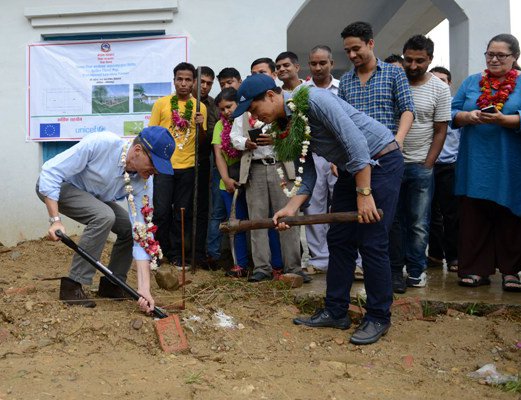
At least 950,000 children in Nepal will not be able to return to school, unless urgent action is taken to provide temporary learning spaces and repair damaged school buildings following the 25 April earthquake – according to UNICEF. Almost 24,000 classrooms were damaged or destroyed in the 7.8 magnitude quake that hit the country 12 days ago, with many suffering further damage in subsequent aftershocks. The scale of the education crisis is expected to grow over the coming days and weeks as additional information flows in from remote areas. Schools are due to reopen on 15 May. “Almost one million children who were enrolled in school before the earthquake could now find they have no school building to return to,” says Tomoo Hozumi, UNICEF’s Representative in Nepal. “Children affected by the earthquake need urgent life-saving assistance like clean water and shelter, but schools in emergencies – even in a temporary setup - play a vital role too. They minimise disruption to children’s education, protect them from exploitation and abuse, and provide them with messages to keep them safe and healthy. Going to school also allows children to regain a vital sense of routine that can help them come to terms with their experiences.” In the severely-affected districts of Gorkha, Sindhupalchok and Nuwakot, it is estimated that more than 90 per cent of schools have been destroyed, while around 80 per cent of school buildings have collapsed in Dhading. In some areas, including Kathmandu and Bhaktapur, approximately nine in ten surviving school buildings have been used as emergency shelters. UNICEF is concerned that great strides made over the last 25 years in increasing primary school enrolment in Nepal – from 64 per cent in 1990 to more than 95 per cent today – could suffer a serious setback in the aftermath of the earthquake. Nepal’s high dropout rate was already a major concern. Around 1.2 million Nepali children between the ages of five and 16 have either never attended school or have dropped out. UNICEF’s experience shows that children who are out of school for extended periods, including during emergencies, become less and less likely to ever return to the classroom. “There is a desperate need to set up alternative learning spaces, assess and repair buildings, and mount a public awareness campaign encouraging families to send their children back to school and preschool,” says Hozumi. “Prolonged interruption to education can be devastating for children’s development and future prospects.” UNICEF and partners are doing everything they can to get children back to education as soon as possible – including working to set up child friendly spaces and temporary learning spaces in 14 districts affected by the earthquake. Work to establish a system to assess the structure and safety of school buildings that are still standing is also underway, while UNICEF is supporting the government to prepare national guidelines on the use of schools as shelter during emergencies. UNICEF has launched a US$50 million appeal to support its humanitarian response to the earthquake in Nepal over the next three months, as part of a wider inter-agency flash appeal.
- TANAHU HYDROPOWER PROEJCT: A Significant Achievement
- Apr 15, 2024
- AMBASSADOR HANAN GODAR: Sharing Pain With A Nepali Family
- Mar 30, 2024
- VISIT OF KfW AND EIB TO NEPAL : Mission Matters
- Mar 25, 2024
- NEPAL BRITAIN SOCIETY: Pratima Pande's Leadership
- Mar 24, 2024
- NEPAL ARMY DAY: Time To Recall Glory
- Mar 15, 2024
















